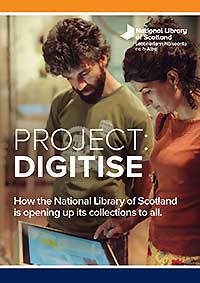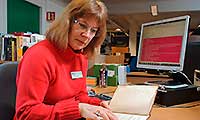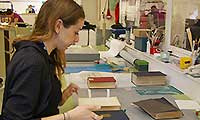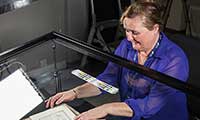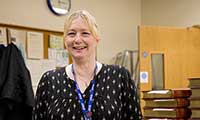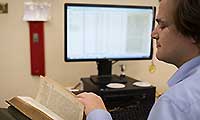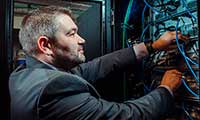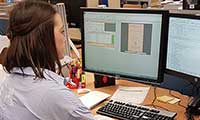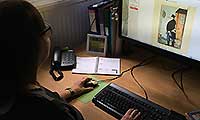At the National Library of Scotland we have set a hugely ambitious target to have a third of our holdings in digital format by 2025.
The volume of information and number of publications that we now receive in digital format via legal deposit will be a huge contributor to the 'one-third' target.
But the other piece of the puzzle — the large scale digitisation of the existing physical items in our collections — requires meticulous planning and implementation.
A team of staff drawn from a number of different Library departments is working at full capacity to prepare, protect, move, and photograph items, and to store and publish digital data. This is a far bigger task than simply scanning the pages of a few books.
We explain on this page — and more fully in the 'Project: Digitise' leaflet — our complex and multifaceted process for digitising hundreds of thousands of items, and revolutionising access to our collections.
Anette, the Curator
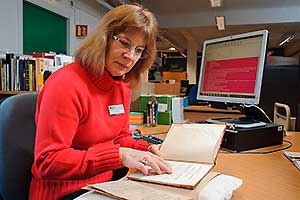
As a Curator in the Library's Rare Books Division I’m involved in the selection and preparation of collection items for digitisation.
Firstly, we think about what people actually want to see. We know that people are most interested in social history, the way we used to live – for example the wealth of information captured in Post Office Directories. So the Library's Scottish holdings of these are now available online.
There are also plenty of logistical considerations to digitising on this scale. For example, how to transport high-value items from our secure strongroom across town to the digitisation suite. Or whether an item is even sturdy or stable enough to be digitised. Whereas early books were hand-printed on high-quality handmade paper, the machine-produced paper used since the early 19th century is rather acidic, making it fragile and vulnerable when it comes to handling.
And you may not realise that we store books by size, rather than by theme or author, in order to make the best use of space. So digitising collections by shelfmark can be the best way to ensure they are processed relatively quickly.
|
My favourite digitisation project was one we did to celebrate 500 years of printing in Scotland. There were 39 printing towns in Scotland by 1800 (whereas in England printing was much more monopolised), and we digitised the first book we had from each of these presses, showing their location on a map. I met an antique book dealer in Skye who told me that he and others in the Gaelic-speaking community had read out some of the 2,300 volumes of Gaelic material we'd digitised on the radio. That was absolutely brilliant, hearing how people use the digitised collections. |

We have very rare and unique items here — for example the first book printed in Scotland — which, unless digitised, would remain inaccessible to most people.
Fred, the Copyright Specialist

Although we're committed to having a third of our collections available in digital format by 2025, there isn't actually a third of our collection automatically out of copyright. So a lot of copyright and assessment work must take place to enable us to clear rights and provide access to the digital collections.
I ensure that we correctly navigate reuse and licensing regulations. Without specialist interpretation we would likely play it safe and digitise only the old, out-of-copyright books — not the manuscripts, films or the family history materials.
When a collection is identified for digitisation I am part of a group that assesses the collection in the stacks. The main thing I look out for is the item's date of production, since the age of something has a bearing on its copyright status. Copyright is normally expired if the creator of the work died more than 70 years ago. In addition, I must consider whether a work has been published; whether the author can be identified; whether it was produced by the Government; and whether it's owned by, or only on deposit with, the Library.
Whereas older materials clear the date hurdle, they often don't have the ISBN, known author, and listed publisher that newer items have. So I help my colleagues work out what we do know about these older items, and therefore what the copyright status of them is.
|
From my perspective, the 3D-scanning of the original stage set for 7:84's production of John McGrath's 'The Cheviot, the Stag and the Black Black Oil' has been a pleasure to work on. Not only is it it very visually striking, but the creator John Byrne was very willing to give us permission to capture it! |

The reality is that people expect information to be digital and at their fingertips nowadays. This applies to the Library's collections, too. It's good to 'be digital' — to keep up.
Mary, the Conservator
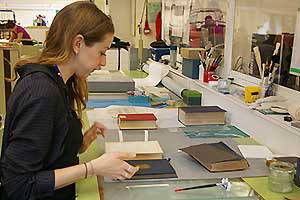
In total ten different Library departments are involved in making a collection available digitally. A digitisation project kicks off with a stack visit by these teams.
My role is to condition check the items as we go along, to make a quick assessment of how much conservation treatment they will need before they can go to the camera.
Then I turn to my 'bench work' in the conservation studio – to the actual treatment of collection items going to be digitised. Treatment is limited to minor repairs to improve safe handling and legibility of content. It was just me working on 'digital preparation conservation' until recently. But now, to accommodate the huge scale-up and the complexity of handling the Library's most fragile collections, other conservators have become involved.
Very occasionally an item is simply too fragile to be digitised. Putting it on a book cradle and under a camera would threaten the structure or the content. We have to protect the integrity of the national collection.
Of course digitisation usually plays an important role in preservation and posterity. But it is also important for hugely increasing access to the Library's collections. And it makes an item much more searchable — for example, you can zoom right in on obscure annotations or marginalia — including the scribbles of distracted monks working in mediaeval times.
|
I really liked working on the digitisation of the 700-year-old Sweetheart Breviary — it was such an aesthetically lovely object. It's a small volume with cockled parchment pages, and it's full of beautiful illuminations and gilding. I'm lucky to have the luxury of being allowed to look at these incredible items closely — a sneak peek before they go to be digitised and are opened up for all to see. |

The Library's ambitious digitisation target is a stake in the ground – an opportunity to provide access to the collections in the broadest possible sense.
Betty, the Photographer
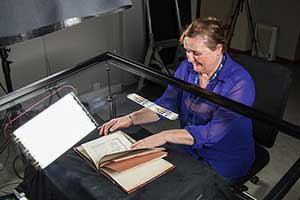
I am responsible for photographing the more tricky items nominated for digitisation. The equipment I use – a camera, a book cradle, a compressor, lights and a digital scanning back — is very expensive. It was bought to digitise the Library's John Murray Archive.
You need to have a bit of technical troubleshooting knowledge — for example how to drain the cradle compressor, fill it with oil, change lenses and calibrate lights. I went to night school to learn the photography skills I needed to start digitising the Library's collections years ago. My skills and workload have evolved a lot in that time – and will no doubt continue to as we plough on with the mass digitisation project!
Just now I'm capturing the Edinburgh Fringe Festival programmes dating back to the 1970s. At the camera, as we turn each page of an item, we see how fragile some of them are. So I'm conscious that there is a large conservation element to digitisation. It will cut down on how often some of the more precious and fragile items need to be handled and physically consulted.
At the moment I'm also tasked with digitising 2,000 broadsides. This will take a few weeks since the items are large. It'll need to be shot in sections and then 'stitched' together to produce the complete image.
This type of post-processing can take a lot longer than the actual capture. We have to check colour balance, focus and pagination, and straighten and crop the images … and that's before the images even go to my colleagues for quality assurance, ingest, metadata and online publication!
|
One of the most memorable digital capture projects I've worked on was an army paybook that a soldier had in his front pocket when he was shot in combat. The bullet entered the book and saved his life. When we zoomed in to the image you could still see the blood around the edges of the bullet hole. |

We're digitising in order to provide remote access — so that people don't have to come into the Library from the US or Australia or wherever. Digitisation is the best option, isn't it?
Francine, the Ingester
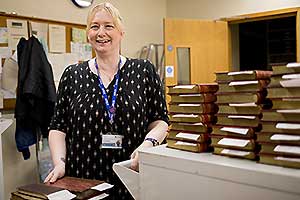
It's far from the truth that digitisation is a quick process which is all about capture. Part of my job involves 'ingesting' digital items – an essential part of the puzzle without which none of our digitised collections would go online.
I ingest the data – so import it into our repository where it is stored – in batches of 5,000 pages at a time, which takes about five hours. Such is the scale of what we’re doing that I run five computers at the same time. Just this morning the items ingested included 'Mrs Nourse's Modern Practical Pastry and Pickling' (featuring an illustrated guide to trussing a rabbit), 'Lizar's Scottish Tourist' and 'Ancient History of the Egyptians and Carthaginians'.
It's the scale at which we're digitising the Library's collections that complicates things. We need the best technology, the best processes and huge amounts of digital storage.
The best bit about my job is going online and seeing the books on the screen, available far and wide, and thinking 'I did that'. Getting positive feedback from people is also really encouraging. For example, the Military Lists which were recently digitised were difficult to work on, but have proven so valuable to people. That's the beauty of it.
|
My favourite item that I've been involved in digitising was the Library’s Medical History of British India collection. It's a rare collection, as the copies which existed in India were mostly destroyed by heat or humidity. Our digitised copies are therefore consulted often by Indian academics. The 1878 'Lock Hospital Report' from the collection was fascinating. A lock hospital was where sexually transmitted diseases were treated, when prostitutes were sanctioned as a way of keeping young officers busy and out of trouble. The papers document the British colonists' attitudes to such women which both surprised and angered me. It captured my imagination to such an extent that I completed a university module on the topic and became quite an expert in the history of medicine! |

We have such a fantastic collection — why have it all hidden in the stacks? Digitisation is really good for access, for opening our collections up.
Thomas, the Quality Assurer
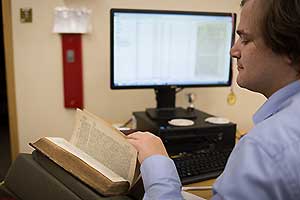
Most of my time is spent checking the images that our camera operators shoot. I usually manage to keep up with them, checking every page of every book — so around 3,500 pages / images a day. I can't spend very long on every page, just a couple of seconds. I check the page number, clarity of the image and the alignment of text. Every hundred or so pages I do a more detailed spot-check.
If my role didn't exist, if pictures were just uploaded without any quality control, we'd find that there were pages missing, that some were at a funny angle, that images were distorted.
It would be quite annoying for anybody reading through a volume to click to the next page and find one of these things wrong.
Digital copies are a fall-back, a copy of every physical item the Library would lose if — heaven forbid — it was to burn down. Similarly, it could protect books if digitisation means that they are handled less and exposed to less damage.
|
I'm always coming across something a bit odd that sparks my interest. For example, quite recently I turned the page to a recipe in a Victorian cookery book for a sheep's head. I'm also interested in the early railroad travel guides. I recently glanced at the pages of a book on the first Tay Bridge, saying how great it was, but published a year before it fell down! |

The Library's collections are so varied. Our digitisation programme lets people on the other side of the world see what we have – we have so much!
Alastair, the Digital Infrastructure Specialist

The scale of data storage at the Library is phenomenal. Whilst we currently store one petabyte (one million gigabytes), the storage we need for the digitisation project will increase tenfold in the next five years. We'll never delete the data, as other industries do — the whole point is to archive the data.
And so the biggest challenges for us are without a doubt storage, infrastructure and redundancy. We're looking at how to compress files to save space, but without reducing the quality. The size of the data presents issues when it comes to backing up. It's a constant rolling upgrade of hardware and software.
Each storage format is vulnerable in some way or other, but by keeping three copies of everything we digitise we safeguard against loss — for example from fire, flooding and ransomware. By storing the third copy in the Cloud we can also safeguard in the best way possible against obsolescence of our own equipment.
Digitisation is providing the only means for some collections, which are too rare and fragile to view in person, to be accessed. And our collections are made available to people who can't get to the Library for whatever reason.
|
The Library's digitised map collections are unrivalled. My son and I have had great fun at home zooming in and clicking around on 17th century maps. My favourite is the 'Chimney Map' recently rescued and restored by the Library's conservators. |

I think the commitment to have a third of our collections in digital format by 2025 is pretty amazing. You don't see many doing this. It's a bold and pioneering statement.
Kirsten, the Metadata-Creator
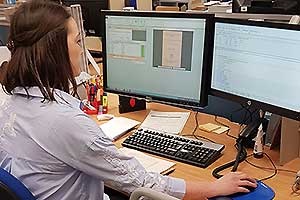
I enjoy visiting a collection in situ in the Library's stacks before it starts to be digitised, since this is when a curator will explain what the importance or value of the collection is.
After that, my contribution to digitisation is adding the descriptive metadata. There's a lot of manual cataloguing work, but without it the digital images we take of our collections would not be found or explored by users online. A lot goes into making the images discoverable to the public, and giving them a better experience by presenting information in new formats. I come up with a description for the item, then add supplementary shelfmark, title, and publication information. I pass this information on to our Web Editor, who works with the curator to come up with a title and description of the item for the web page.
So far I've mostly been working on the Antiquarian Books of Scotland collection of hundreds of volumes. I've been able to produce the metadata for around 50 of them a day. Next I'll be working on An Comunn Gàidhealach programmes, First World War casualty and death lists, and 40 volumes contained with specialist 1700s bindings.
|
I found the project to digitise exam papers from 1889-1963 very interesting. There are some very odd things in there, including questions in the home economics papers (for females only) such as 'how would you get rid of a chocolate stain with a flannel?'. It's a snapshot of social history. |

The reason we're digitising is for the users' experience. By transforming our collections into new formats we’re making them more discoverable, bringing them to more people.
Alison, the Web Editor
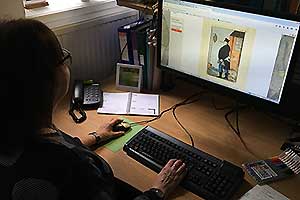
I work with the curator to come up with a 'top-level description' for the digital images of a collection. It's important that it's in Plain English, and that it's both concise and informative, so that it is as accessible as possible to a general audience.
Then I add a brief description and an image to the Digital Gallery on the Library's website. We group the digital collections into categories in the Digital Gallery. This makes it easier for people with an interest in photography, or war, or maps, for instance, to find all the digitised collections that relate to that topic.
The digitisation project feeds into the Library's ability to provide access to knowledge for everyone. These days, when more people visit us online than in person, that means digitally.
|
The Post Office directories are my favourite digitised collection. We took something that was well used in the reading rooms by people researching their family history and put it online, and the fact that it's had so much web use shows that we've met a need that a lot of family history researchers had – in Scotland, across the UK, and beyond. It's exactly the sort of content that the Library should be delivering online. |

The Library has a responsibility to make as much of its collections as possible available to the public. These days that means digitally.
You can read more about the Library’s mass digitisation in the 'Project: Digitise' leaflet (PDF) (2 MB; 16 pages).
Follow the National Library of Scotland's social media accounts for recent updates and examples of the digitisation project.

